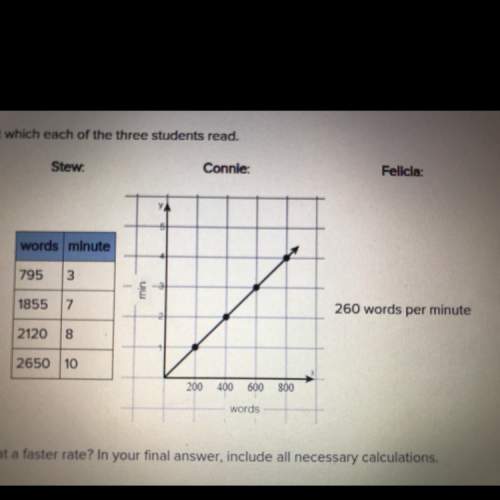
Mathematics, 07.10.2019 23:30 jeffmacdonald1976
Astronauts increased in height by an average of approximately 40 mm (about an inch and a half)during theapollo-soyuzmissions, due to the absence of gravity compressing their spines duringtheir time in space. does something similar happen here on earth? an experiment supported bynasa measured the heights of six men immediately before going to bed, and then again after threedays of bed rest (styf et al. 1997). on average, they increased in height by 14 mm, with standarddeviation 0.66 mm. find the 95% confidence interval for the change in height after three days ofbed rest.

Answers: 3


Another question on Mathematics

Mathematics, 21.06.2019 19:30
Suppose i pick a jelly bean at random from a box containing one red and eleven blue ones. i record the color and put the jelly bean back in the box. if i do this three times, what is the probability of getting a blue jelly bean each time? (round your answer to three decimal places.)
Answers: 1

Mathematics, 21.06.2019 21:30
Atrain leaves little? rock, arkansas, and travels north at 90 kilometers per hour. another train leaves at the same time and travels south at 80 kilometers per hour. how long will it take before they are 680 kilometers? apart?
Answers: 1

Mathematics, 22.06.2019 01:00
The table showed price paid per concert ticket on a popular online auction site. what was the average price paid per ticket
Answers: 1

Mathematics, 22.06.2019 03:00
In this problem, we explore the effect on the standard deviation of multiplying each data value in a data set by the same constant. consider the data set 14, 6, 8, 15, 15. (a) use the defining formula, the computation formula, or a calculator to compute s. (round your answer to one decimal place.) s = 4.28 (b) multiply each data value by 3 to obtain the new data set 42, 18, 24, 45, 45. compute s. (round your answer to one decimal place.) s = 12.83 (c) compare the results of parts (a) and (b). in general, how does the standard deviation change if each data value is multiplied by a constant c? multiplying each data value by the same constant c results in the standard deviation remaining the same. multiplying each data value by the same constant c results in the standard deviation being |c| times as large. multiplying each data value by the same constant c results in the standard deviation increasing by c units. multiplying each data value by the same constant c results in the standard deviation being |c| times smaller. (d) you recorded the weekly distances you bicycled in miles and computed the standard deviation to be s = 3.8 miles. your friend wants to know the standard deviation in kilometers. do you need to redo all the calculations? yes no given 1 mile ≠1.6 kilometers, what is the standard deviation in kilometers? (enter your answer to two decimal places.)
Answers: 1
You know the right answer?
Astronauts increased in height by an average of approximately 40 mm (about an inch and a half)during...
Questions


Physics, 26.08.2021 17:40



Mathematics, 26.08.2021 17:40

Computers and Technology, 26.08.2021 17:40


Mathematics, 26.08.2021 17:40







Mathematics, 26.08.2021 17:40



Mathematics, 26.08.2021 17:40

English, 26.08.2021 17:40




